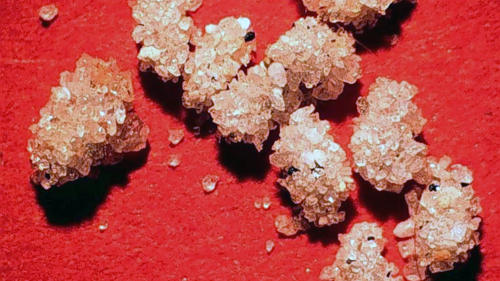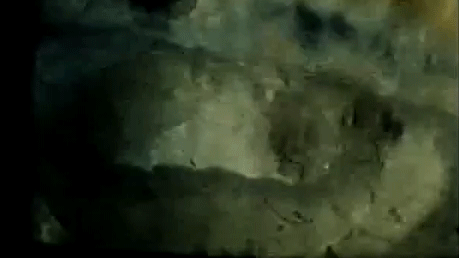
Img 1 Cat flea cocoons camouflaged with environmental debris (sand).
Summary
Cat flea cocoons are 4-5 mm long, and 2 mm thick. They’re composed of white silk. The sticky silk accumulates nearby debris, which camouflages the cocoon into the environment. Flea cocoons are oval-shaped and look like a lint ball or dirt clod. However, they’re rarely seen because fleas pupate deep within carpets.
Details
Size
Mature flea larvae are 4-5 mm long, and 0.5 mm wide. While forming cocoons, the larvae fold themselves in half (called U-shaped or V-shaped larvae). The doubled-over larvae spin sticky silk around themselves, which collects debris. With all components combined (larva, silk, and debris), flea cocoons are 4-5 mm long, and 2 mm wide.
Shape
Flea cocoons are irregular, tent-like structures. However, they take on an oval shape once they’re fully formed. The ovoid cocoons resemble small lint balls or dirt clods. Occasionally, two larvae will spin cocoons in close proximity to each other. In these rare circumstances, there may be a combined, double cocoon.
Color & Composition
Sticky Silk & Debris
Flea cocoons are envelopes of thin, white, silk-like material. The fibers are soft, moist, and sticky. They’re wrapped loosely around the larvae. As a result, environmental debris easily adheres to cocoons. This detritus may consist of sand, dust, soil, carpet fibers, or any other small fragments of dry material. The larvae purposefully collect and integrate these particles into their cocoons with a few silk threads. From inside the loose structure, the larvae then thicken the interior walls with more silk Img 2.

Img 2 A cat flea larva reinforcing the interior of its cocoon with silk. Silk is excreted from labial (salivary) glands.
Camouflage
Flea cocoons are difficult to detect. Adhering debris originates from the same environment where the cocoons rest, giving them a near perfect camouflage. Within homes, larvae pupate at the base of carpeting. The cocoons are hidden from view, and tightly bound into the carpet fibers. Larvae may also pupate in other dark, undisturbed locations. Cocoons can be found in floor crevices, within pet bedding, or under furniture.
The Silk
Physical Characteristics
Flea larvae have modified labial (salivary) glands which produce silk. Their mandibles attach the silk to the desired location. The silk is white, soft, and moist. It slightly hardens over a few days. Cat fleas, like other body fleas, have soft cocoons. Nest fleas typically have firm cocoons.
Composition
Flea silk proteins have a predominantly α-helical conformation. The silk’s composition has low levels of glycine and high levels of glutamic acid residues. Preliminary data suggests the silk is more like keratin and myosin than it is like aculeate silks.
Movement
Cocoon Formation & Molting
Fully-grown larvae enter into a period of inactivity before spinning a cocoon. Once construction begins, the cocoon is completed in 6.7 hours. Then movement ceases again. Pupation then begins in 17.8 hours. Within its cocoon, the U-shaped larva remains motionless as it transitions into an adult over 3-6 days. Two molts occur within the cocoon: From larvae to pupae, and from pupae to adult. At each molt, there’s a short burst of activity. The shed cuticles (skins) remain within the cocoon.
Pre-Emerged Adult
Once adulthood is reached, fleas can remain in a motionless, dormant state inside their cocoons. This quiescent period lasts up to 5 months, but it ends when a nearby host triggers their emergence. The presence of heat or pressure causes them to exit the cocoons within 5 seconds. Fleas that fail to emerge will move around inside their cocoon and then return to a quiescent state.




You must log in to post a comment. Log in now.